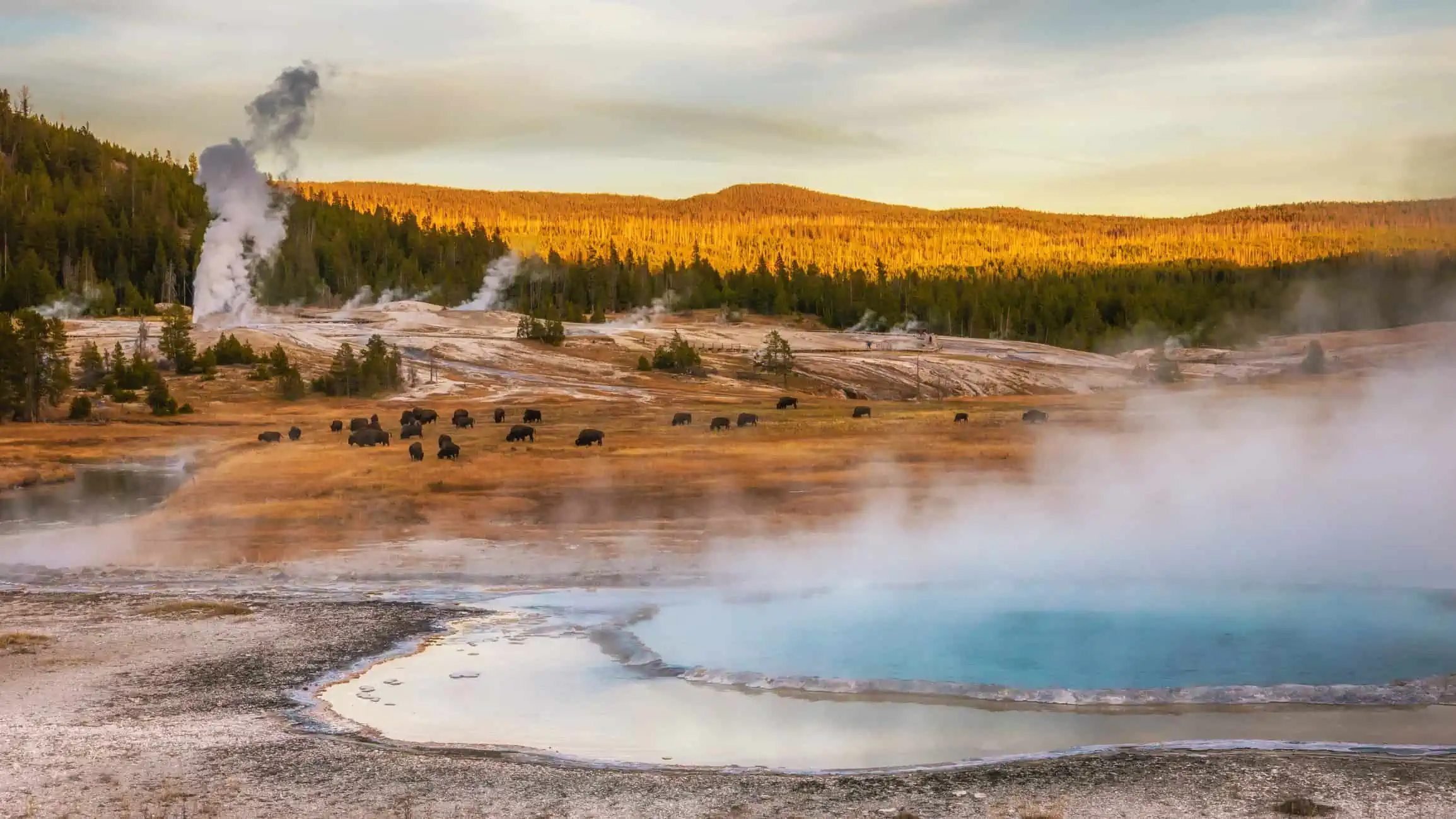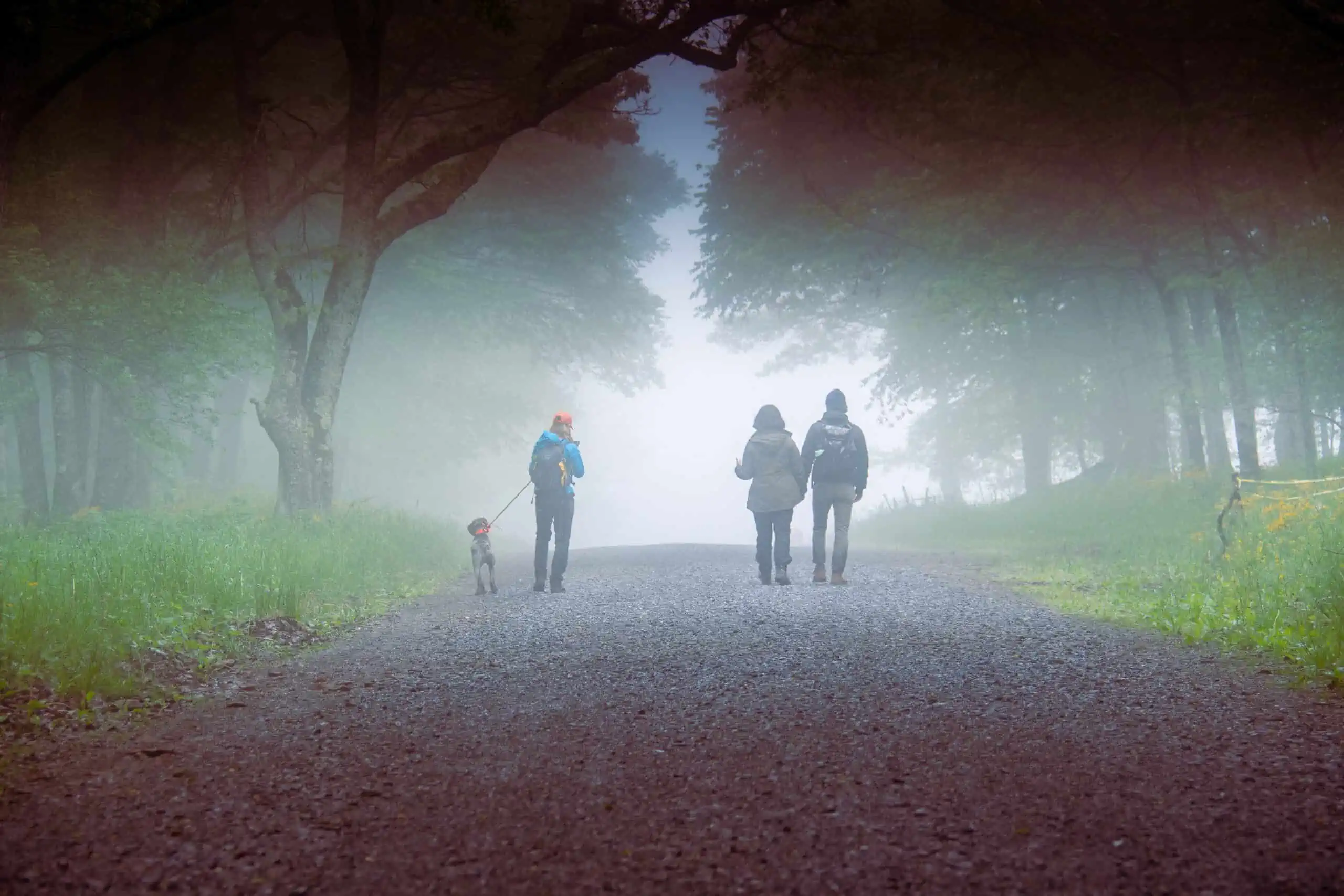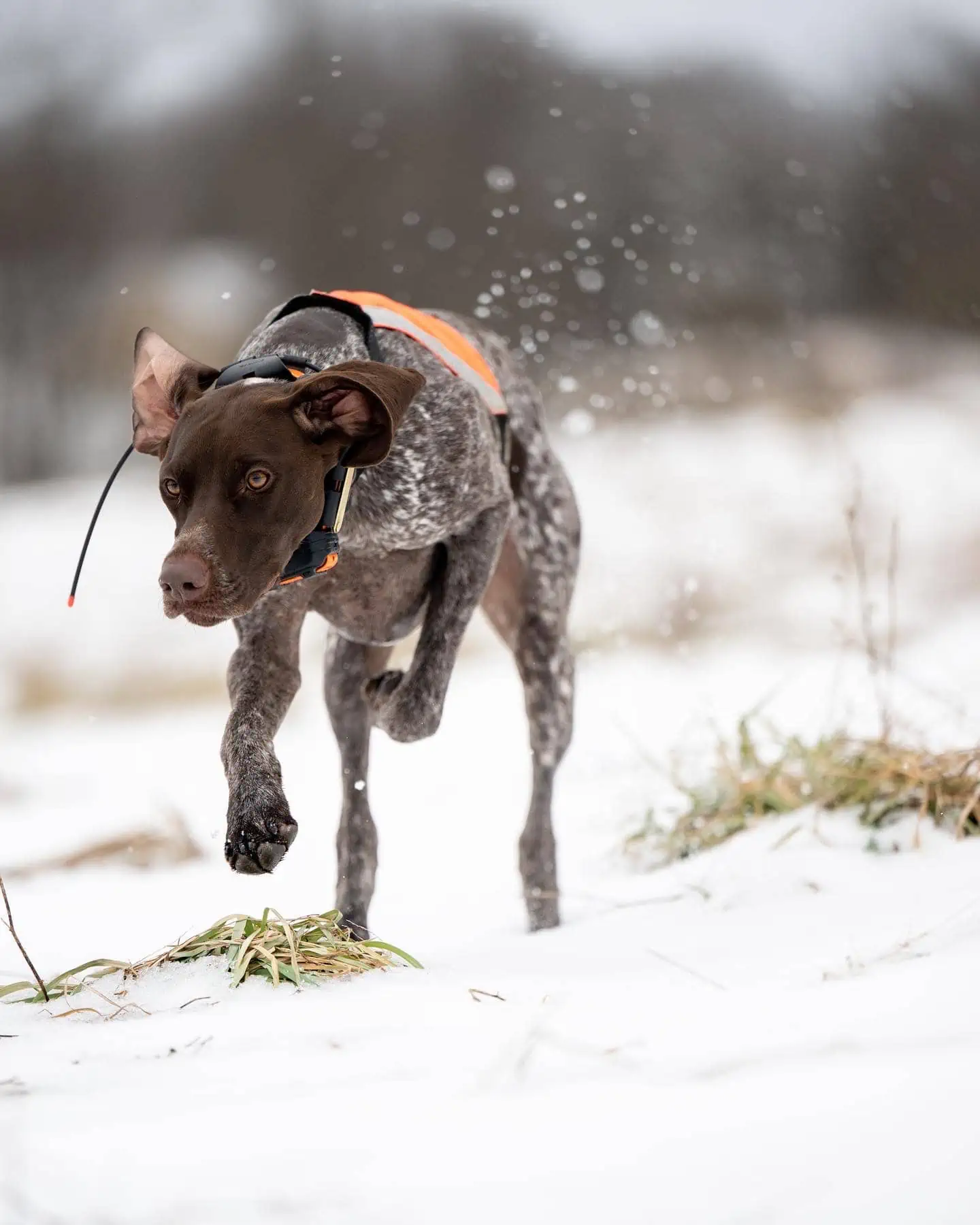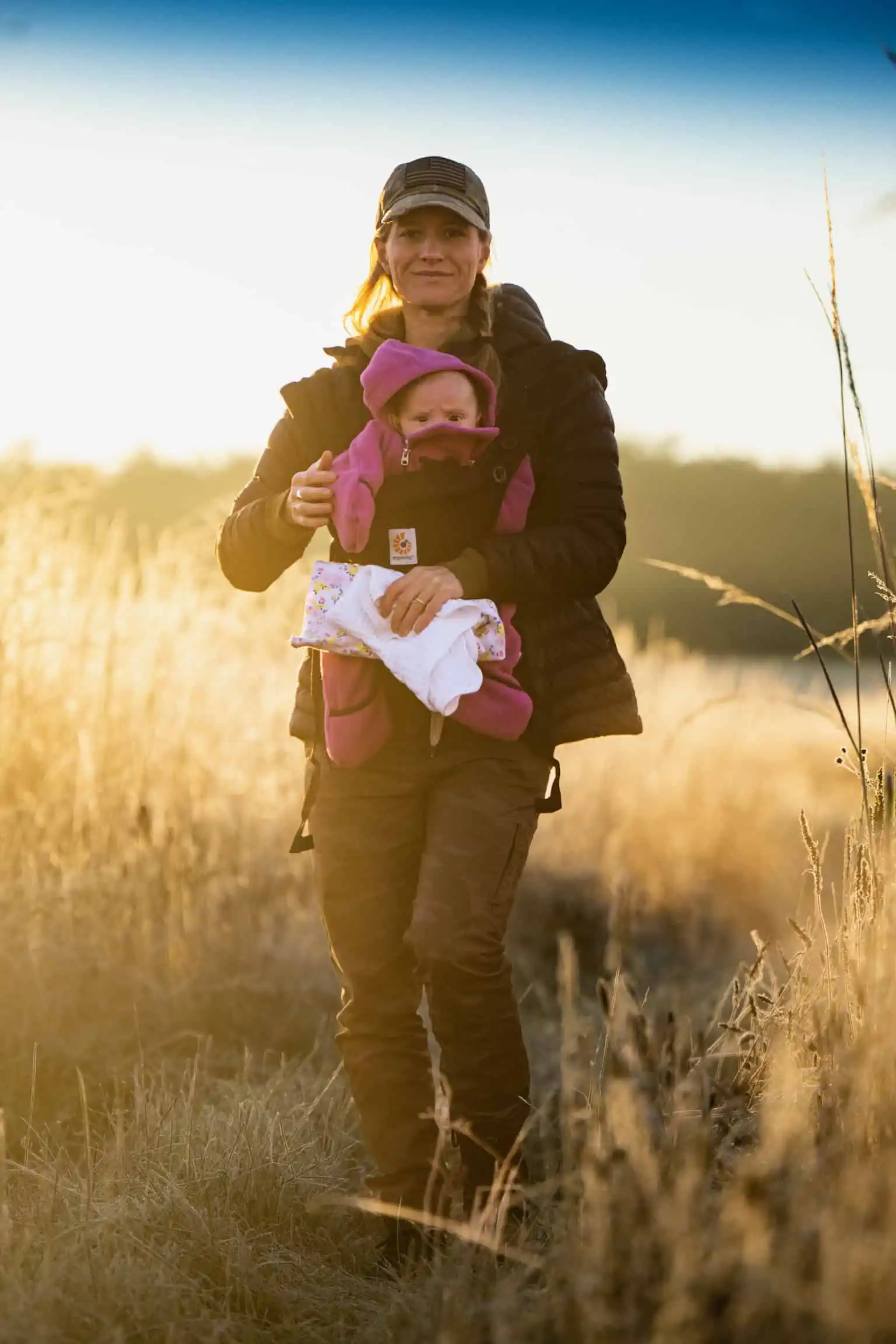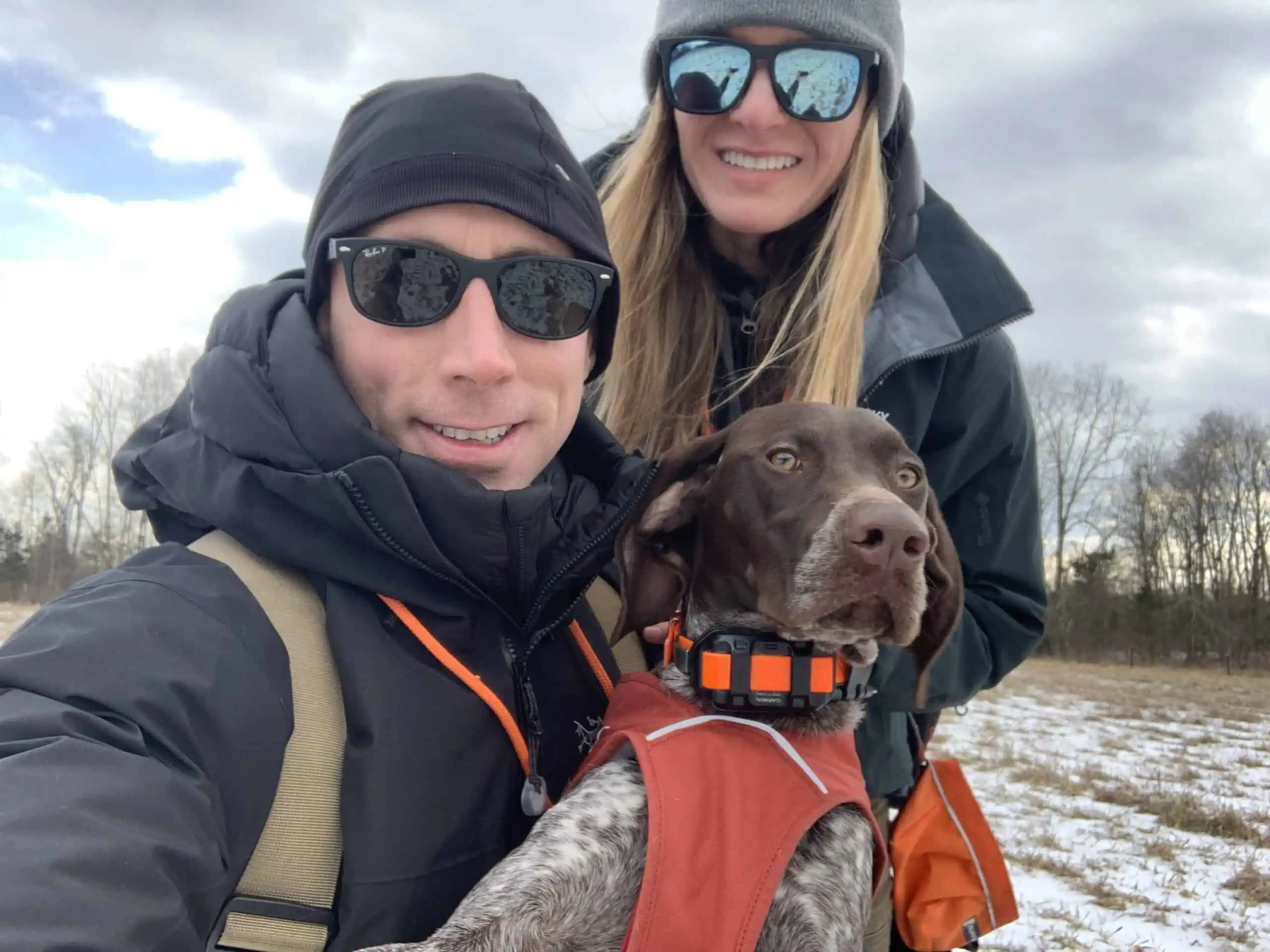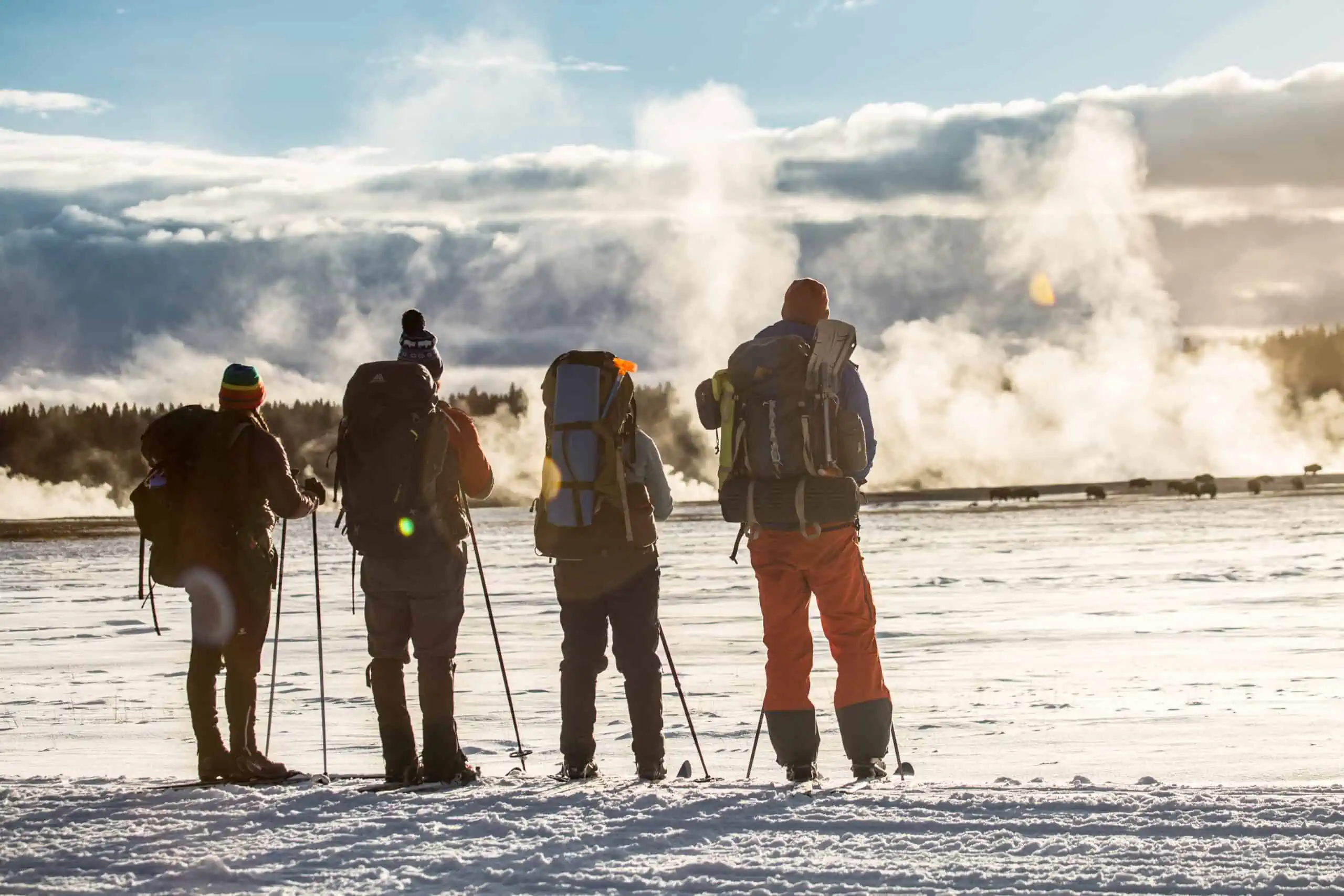The Geyser Basins of Yellowstone
More than 10,000 hydrothermal features are active in Yellowstone. Exploring the geyser basins of Yellowstone is an adventure, for beneath this enchanting landscape lies a sleeping giant—a supervolcano—that powers the captivating spectacle.
Yellowstone National Park, a geothermal wonderland, boasts the highest concentration of geothermal features on Earth. The land here smokes, bubbles, and hisses, thanks to the immense volcanic activity beneath its surface. Each of the major geyser basins offers a unique glimpse into the volcanic activity that shapes this iconic park.
1. Mammoth Hot Springs
Mammoth Hot Springs, located in the northern part of the park, is a captivating display of terraces formed by the interaction of hot water and limestone. These terraces resemble cascading white steps, creating an otherworldly landscape. The hot springs deposit approximately two tons of travertine limestone (calcium carbonate) daily, constantly shaping and reshaping the formations.
Wander along the boardwalks that wind through this surreal landscape, where colorful thermophiles thrive in the warm waters. Don’t miss the iconic Minerva Terrace and Palette Spring, which offer some of the most striking views in the area.

2. Norris Geyser Basin
Norris Geyser Basin, the hottest geyser basin in Yellowstone, is a geothermal wonderland. A research drill hole at Norris found a scorching temperature of 459°F (237°C). Within this basin, you’ll encounter steam vents, geysers, hot springs, fumaroles, and mud pots.
Norris is the home of Steamboat Geyser, the tallest geyser in the world, and the Porcelain Springs, with their vibrant colors. Explore the boardwalks and witness the dynamic geothermal activity in this fascinating basin.
Learn more about Norris Geyser Basin from We’re in the Rockies
Yellowstone National Park: How to Visit and What to See by 21st Century Pioneer
3. Mud Volcano
Head east to Mud Volcano, where you’ll encounter a landscape that resembles a scene from another planet. Explore the area’s bubbling mud pots, which emit a pungent odor due to the presence of hydrogen sulfide gas. Marvel at features like Dragon’s Mouth Spring, where water surges from a cavernous opening, creating an eerie roaring sound reminiscent of a mythical creature.
4. West Thumb Geyser Basin
West Thumb Geyser Basin is unique because it lies along the shores of Yellowstone Lake. Imagine geysers and hot springs juxtaposed against the serene blue waters of the lake. The Abyss Pool, with its deep blue hue, is a standout feature. Stroll along the boardwalks that meander around hot springs, geysers, and colorful pools, all set against the backdrop of the vast lake. Keep an eye out for Fishing Cone, a geyser that once served as a makeshift cooking pot for early visitors.
5. Upper Geyser Basin
No visit to Yellowstone would be complete without experiencing the iconic Upper Geyser Basin, home to the world-famous Old Faithful geyser. Arrive early to secure a prime viewing spot for Old Faithful’s predictable eruptions, which occur approximately every 90 minutes. While waiting, explore the surrounding area, which features numerous other geysers and hot springs, including Castle Geyser, Grand Geyser, and Morning Glory Pool. Be sure to check the predicted eruption times for other geysers to maximize your chances of witnessing these natural wonders in action.

6. Midway Geyser Basin
Midway Geyser Basin is home to some of the park’s most visually stunning thermal features. The Grand Prismatic Spring, a massive pool with vivid colors, is the largest hot spring in the U.S. The spring’s rainbow hues result from microbial activity in the water. The boardwalk leads you to the Grand Prismatic Spring Overlook which offers panoramic views of the spring’s vibrant palette and surrounding landscape. And don’t miss the Excelsior Geyser Crater and Turquoise Pool, both of which add to the area’s surreal beauty.

7. Lower Geyser Basin
Conclude your journey at the Lower Geyser Basin, where the geothermal features are as diverse as they are abundant. Covering approximately 11 square miles, the Lower Geyser Basin is the largest geyser basin in Yellowstone. Its thermal features are spread out in widely spaced groups. While it lacks the density of the Upper Geyser Basin, it compensates with its vastness.
Explore the Fountain Paint Pot area, a collection of bubbling mud pots and colorful hot springs named for their resemblance to paint being stirred. Wander among the geysers of the Fountain Group, including Clepsydra Geyser and Fountain Geyser, which boast impressive eruptions against the backdrop of Yellowstone’s wilderness.
Yellowstone’s geyser basins offer a glimpse into truly unique natural phenomena. As you explore these basins, remember that beneath your feet lies a supervolcano, a sleeping giant that powers this geothermal spectacle. Enjoy the magic, but tread lightly on this fragile and dynamic landscape.
Tips for Exploring Yellowstone’s Geyser Basins:
- Safety First: Always stay on designated trails and boardwalks to avoid the fragile thermal features and potential hazards.
- Timing Is Key: Plan your visit to the major geysers for optimal viewing times, and consult the park’s eruption predictions for an enhanced experience.
- Pack Essentials: Bring plenty of water, sunscreen, sturdy footwear, and layers to accommodate Yellowstone’s ever-changing weather.
- Respect Wildlife: Yellowstone is home to diverse wildlife; maintain a safe distance and never feed or approach animals.
- Embrace the Journey: Take your time to soak in the sights, sounds, and smells of Yellowstone’s geyser basins, and savor the wonder of nature’s marvels.
In the photo at the top, steam rises near the Firehole River from geothermal pools and geysers in Yellowstone National Park. (Photo by Cheryl Ramalho)
Shenandoah 52: Family-Friendly Hiking
The Shenandoah 52 Explorer Series is 23 trail loops, 52 trail segments, and at just over 150 miles the most family-friendly hiking in Shenandoah National Park.
German Shorthaired Pointers (GSP) are not for the faint at heart. They walk into your life, take hold, and wear you down—unless you wear them down first. Daily hikes, early morning walks, and lengthy weekend journeys. Addison had our number from day one. And Addison turned out to be the muse for a family-friendly hiking challenge and an adventure of a lifetime.
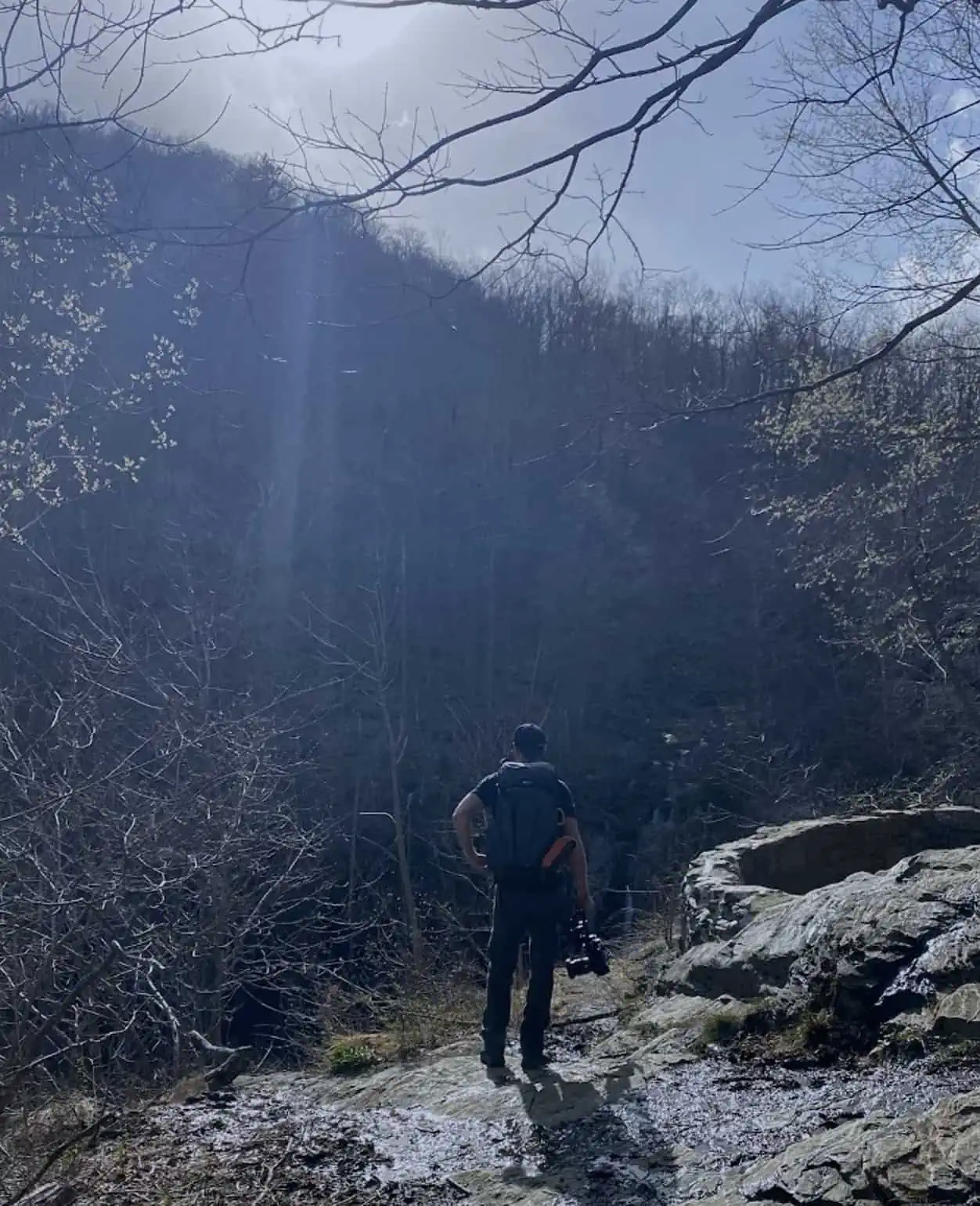

Do you live near Shenandoah National Park? Take the SNP52 Hiking Challenge: 23 trail loops, 52 trail segments and just over 150 miles.
A Pixels and Pointers partnership with the Shenandoah National Park Trust.
When my wife, Tobey, and I found out she was pregnant, we were determined to maintain an active lifestyle for our family. Throughout her pregnancy, we found a rhythm in being outside. By the time Lucy joined us in the world, we were determined to maintain that pace. Mission accomplished—Tobey went into labor the same day we went hiking.
And after that bundle of energy—who I flippantly referred to as the human version of a GSP—arrived on the scene, we really needed a plan. Through trial and error (maybe more like trial by fire) we embarked on all the same journeys.
Within her first month of joining us, Lucy was riding shotgun with Tobey (aka in a baby carrier) at Big Meadows in Shenandoah National Park. Each week and month that followed, we continued to venture into the wilderness. That same fortitude is what brought everything to life.
And by the holiday season of Lucy’s first year with us, we were looking at what the following year had in store for our outdoor adventures. Maybe a little more organized for the new year. Anything to avoid the blow out.
By December we had started to formulate a plan. I remember it like it was yesterday. It was a cold December morning that would put into motion a sequence of events that led to the hiking project. The kind of morning that is written about in a Frost poem. The crystalized ice on the windows, the smell of wood fireplaces, the crackling of the leaves from the dry air.
It was over a cup of coffee that my father and I were discussing the outdoors, and our plan for showing our 4-month-old the things that were important to us. We talked about how important it was that we continue to expose Lucy to the natural world. We felt teaching our child about nature and seeing her big sister (the GSP) enjoy the world around her would be important to her development.
In that same conversation with my father, we discussed one of the Shenandoah National Park hiking challenges that’s been around for a few years. We tinkered with the idea of trying the Shenandoah 500—a long-standing challenge to hike on every trail in the park. We both agreed it would be a hefty adventure to embark on. Mostly because the Shenandoah 500 is not 500 miles, it’s more like 700 or 800 miles because many of the trails require doubling back, and a handful are overnight treks. Pre-parent life, it would have been completely doable, for sure. Post, not so much.
We decided perhaps there was an alternative. My father suggested I utilize my skills with mapping and my understanding of Shenandoah National Park to find trails and treks that would be reasonable to complete. Over the years we had spent quite a bit of time in the park, and had hiked hundreds of miles up and down the North, Central, and Southern Districts that year. Why not formalize our knowledge and approach this with a similar format to the Shenandoah 500?
Crafting an adventure with our 4-month-old addition to the family would require looking at the National Park in a new way, using topographic maps and understanding lengths, elevations, and reasonable treks for hiking in the park.
That evening, I sat down in front of my laptop and started to tag the loops I believed worthy of a family-friendly adventure, what the lengths would be, and how we’d approach them. This was the birth of the SNP52. By the end of the evening, I had tagged about 25 trail loops through the three districts of the park, each less than 10 miles long.
By the turn of the clock to 2023, we had launched The Shenandoah 52 (SNP52)—23 hiking loops in Shenandoah National Park—covering 52 trail segments and approximately 150 miles in the South, Central, and North Districts.
We published all the trails on the website, complemented with hiking resources, all on a digital platform with mobile and GPS resources to take on the trails. As the project continued, we decided to start filming each of the trails.
See all of Kevin’s videos of the Shenandoah 52 here.
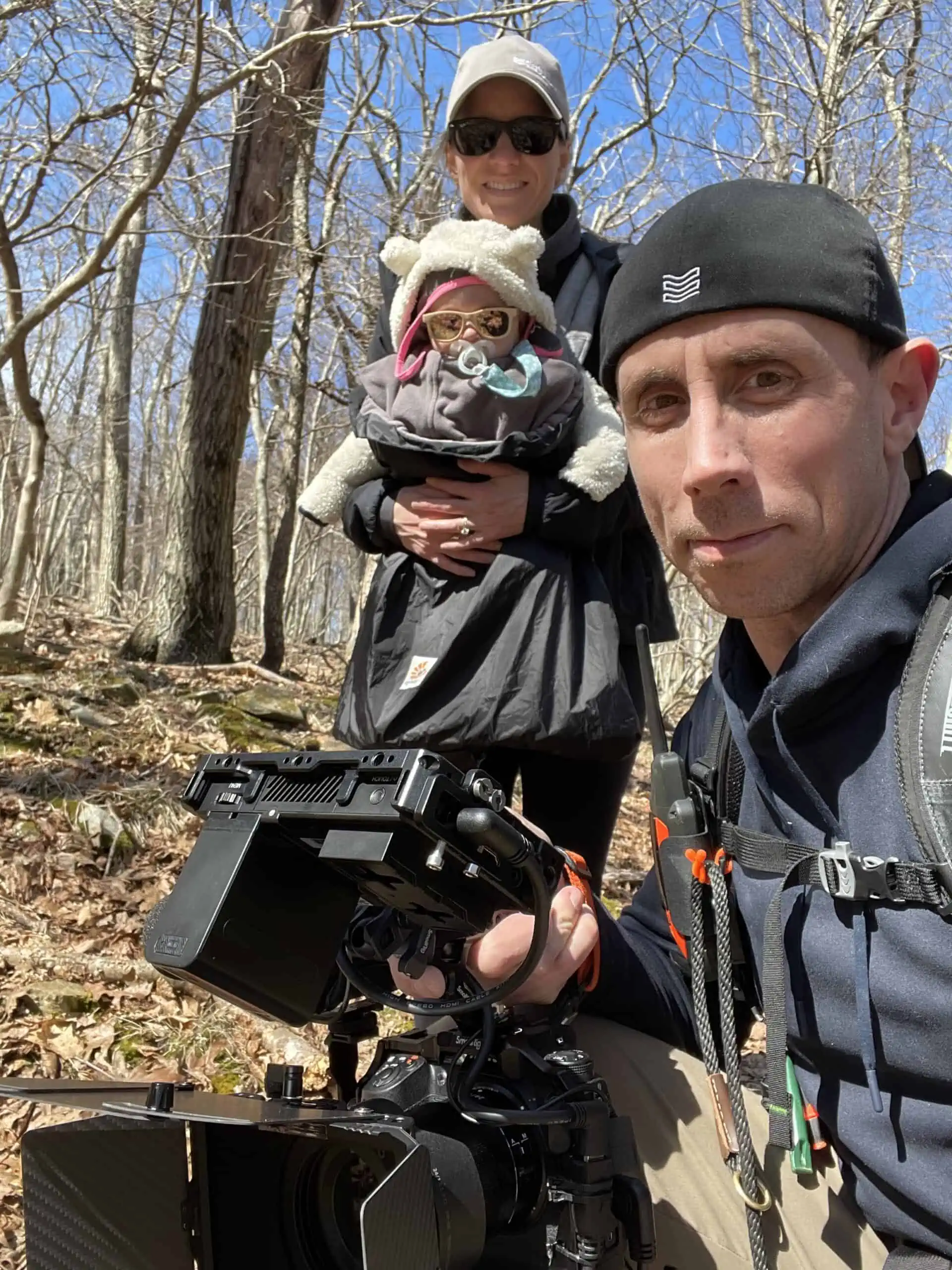
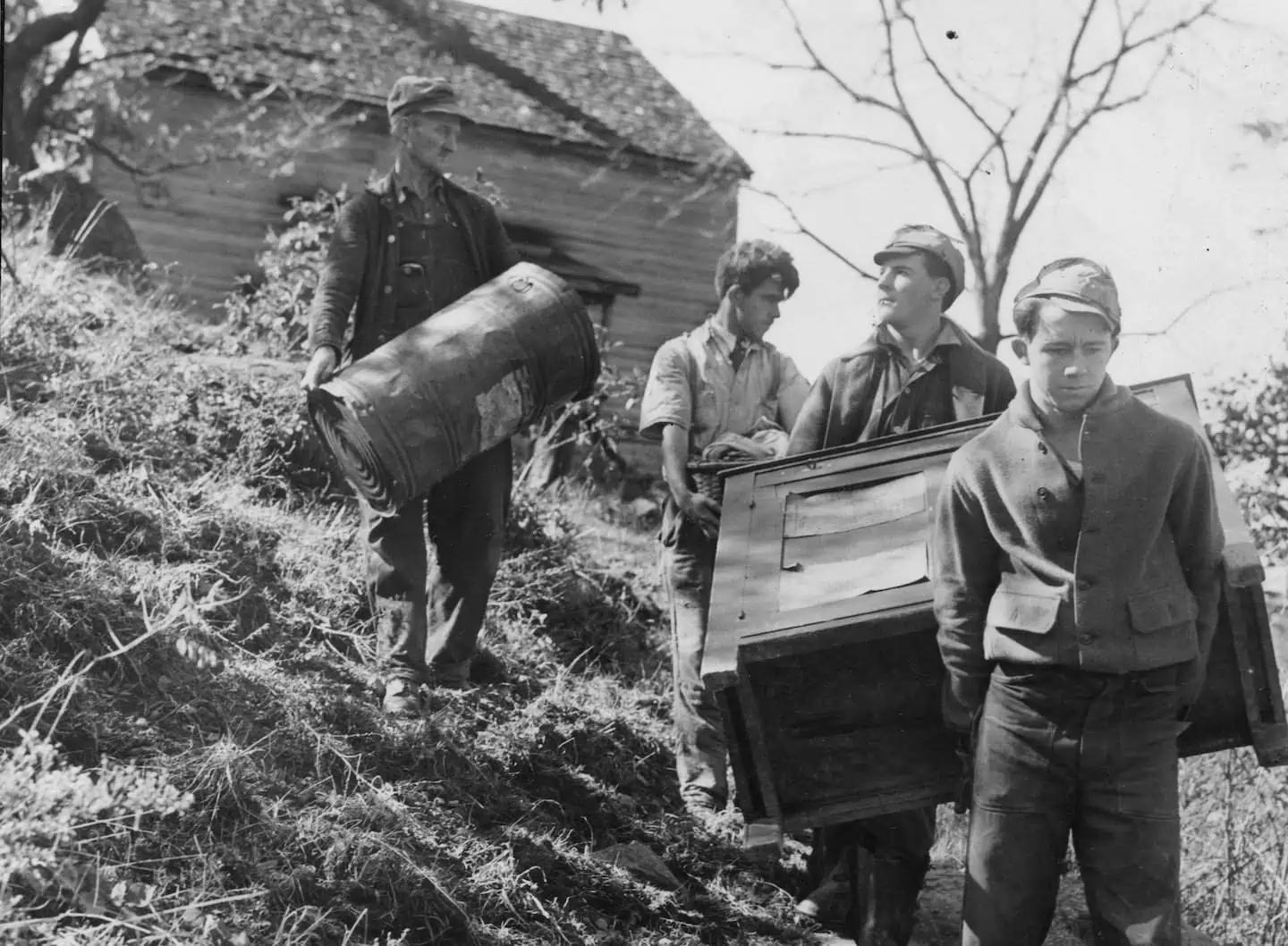
By that time, I had purchased a few books on the park. I thought I would throw some history into my videos. Why not? Seemed harmless to blend park history with footage of its trails, creating a narrative for the viewers. I almost need a narrator to enter your head right now to say, “that was not the case” for dramatic effect. Because … that was not the case.
You see, the history of Shenandoah National Park is not straightforward. While some national parks may have interesting stories and colorful folklore, that was not Shenandoah. The hiking challenge together with the trail videos morphed into the filming of experts, historians, and the community to tell the park’s story. Few have attempted to tell a complete story of Shenandoah through the voice of the people, including many of the families who were displaced during the formation of the park. We felt, what better way than coupled with a hiking project?
Fast forward to today, we have 3 components to the SNP 52 Hiking Project:
- Shenandoah 52, Explorer Series: Full 150 miles of hiking trails in loop format as the anchor challenge. Designed for those who seek an aspirational expedition outside.
- Shenandoah 25, Adventure Series: Reduced trail lengths in out-and-back formats on all trails for families, children, and beginners to start their journey through the park.
- Documentary Film: Docuseries in partnership with the Shenandoah National Park Trust focused on the elements of the park including history, the community, and the park’s evolution.
It’s a worthy challenge and even better way to bring the family closer to one another, one step at a time. Especially since Tobey insists on being able to tell Lucy that she carried her on each of the 52 trail segments. You can learn more about the SNP52 Hiking Project at www.snp52.com.
Secrets to a Magical Winter in Yellowstone
Only a fraction of Yellowstone’s 4 million visitors choose to explore the park in the winter. Although much of the park is shut down with subzero temperatures, it's still worth a visit. Cheryl Schoss of We're In The Rockies offers expert insights for a magical winter in Yellowstone.
Yellowstone’s official winter season usually goes from mid-December through mid-March, depending on the snowpack. Guests can snowmobile, snowshoe, cross-country ski, ice skate, view wildlife, and go on snow coach tours. Yellowstone is so different in the winter, it’s almost like visiting a completely different park. Very few roads within the park are plowed so most visitors work with a tour company to make transportation arrangements via snow coach or snowmobile.
My husband, Matt, and I write travel guides to help people visit the West. We love Yellowstone and visit every year. Last year we visited Yellowstone in February and had a spectacular experience. Read on to learn all about it and see if a trip to Yellowstone in the winter is for you.
When is the Official Winter Season in Yellowstone?
Snow can begin to fall as early as October. The NPS allows the snow to accumulate on most of the roads. From late October through mid-December there aren’t many park services running at all until a good snowpack is formed, making the roads passable for snow coaches and snowmobiles.
All the lodges and restaurants close for the winter except the Old Faithful Snow Lodge and Mammoth Hotel and Cabins. We chose to stay at the Old Faithful Snow Lodge on our last trip and we loved the cute little cabin we stayed in.
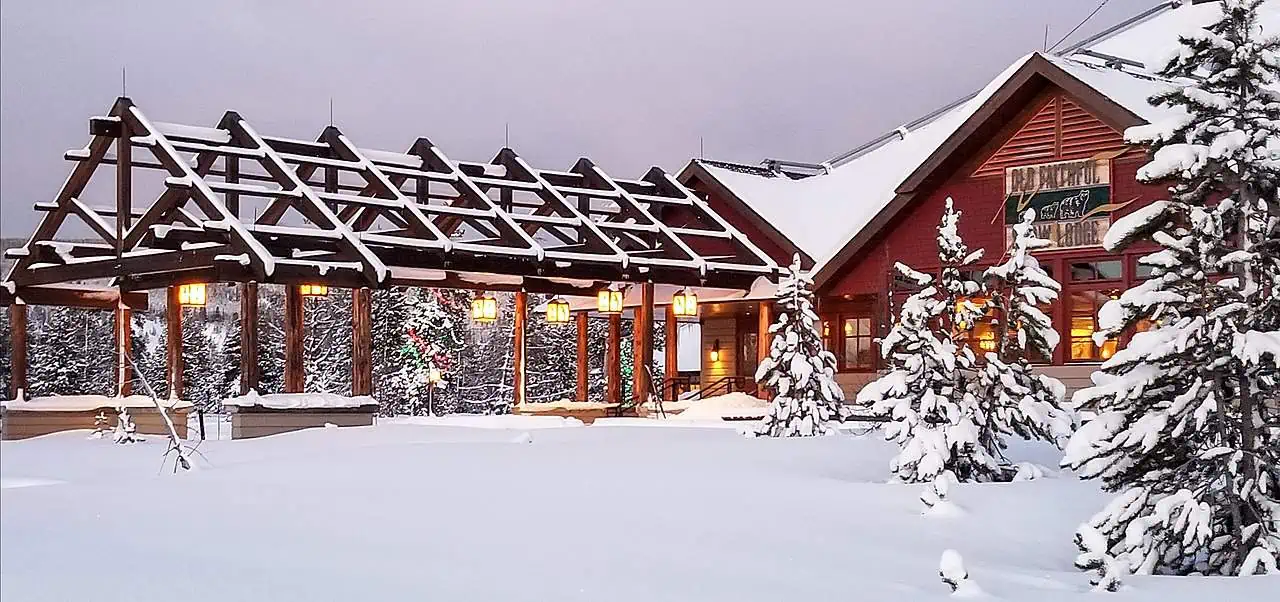
We were pretty shocked that the only place to get dinner there was the Obsidian Dining Room and you needed a reservation for that! The Geyser Grill is open for lunch. The Mammoth area also has a couple of restaurants open.
Gateway towns like West Yellowstone and Gardiner still have plenty of restaurants and hotels open but a lot of their normal tourist services are limited. We were super excited that Melba from Optics Yellowstone in Gardiner agreed to let us rent a scope from her so we could watch wolves (more on that later!)
The NPS begins the herculean task of removing snow from the roads in mid-March and the park is pretty much shut down until they can make the roads passable again. Memorial Day is usually the kick-off for the summer travel season.
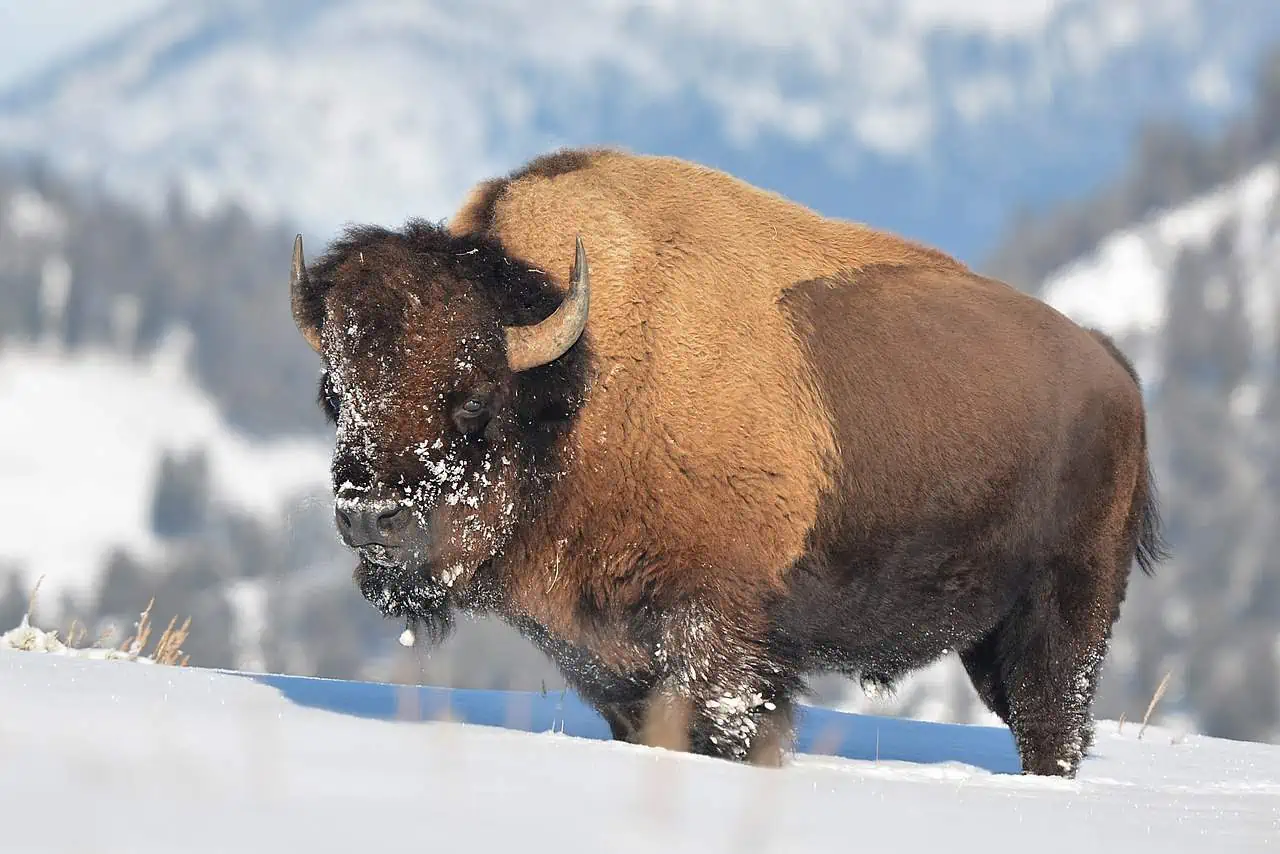
What Are the Road Conditions Like?
Unlike the rest of the park where roads are impassable for all vehicles besides snowmobiles or snow coaches, portions of the Grand Loop Road at the north end of the park and the road to Lamar Valley are plowed throughout winter. The small mountain towns of Cooke City and Silvergate would be cut off from essential services if these roads weren’t regularly cleared.
Both town residents and regular visitors are allowed to access these roads but 4-wheel drive and chains are certainly recommended.
Even with best efforts to keep these roads plowed, a snowstorm can temporarily shut down these roads. The park has very few visitors in the winter and getting stranded on the side of the road in a snowstorm is dangerous because it could be hours before you are found. Always know what the weather forecast is before leaving on an adventure.
How Cold Does It Get?
So cold!! Even though I love Yellowstone, I was a bit gun-shy to make the trip in the winter because the temperatures can range from 0 to -20 degrees Fahrenheit. It really is that cold the entire day, most days.
Matt and I shot a few YouTube videos there and it was hard to talk because our faces were so cold. Holding our cameras with our bare hands was sheer torture! One night I left oranges in our car and woke up to find that my fruit for breakfast had turned into rock-solid iceballs. You get the idea. It’s cold!
We found that the temperatures were more bearable when the sun was out. It was also helpful if we were doing something active, like snowshoeing. It made a big difference. If it was windy or snowing, we tried to get indoors ASAP.
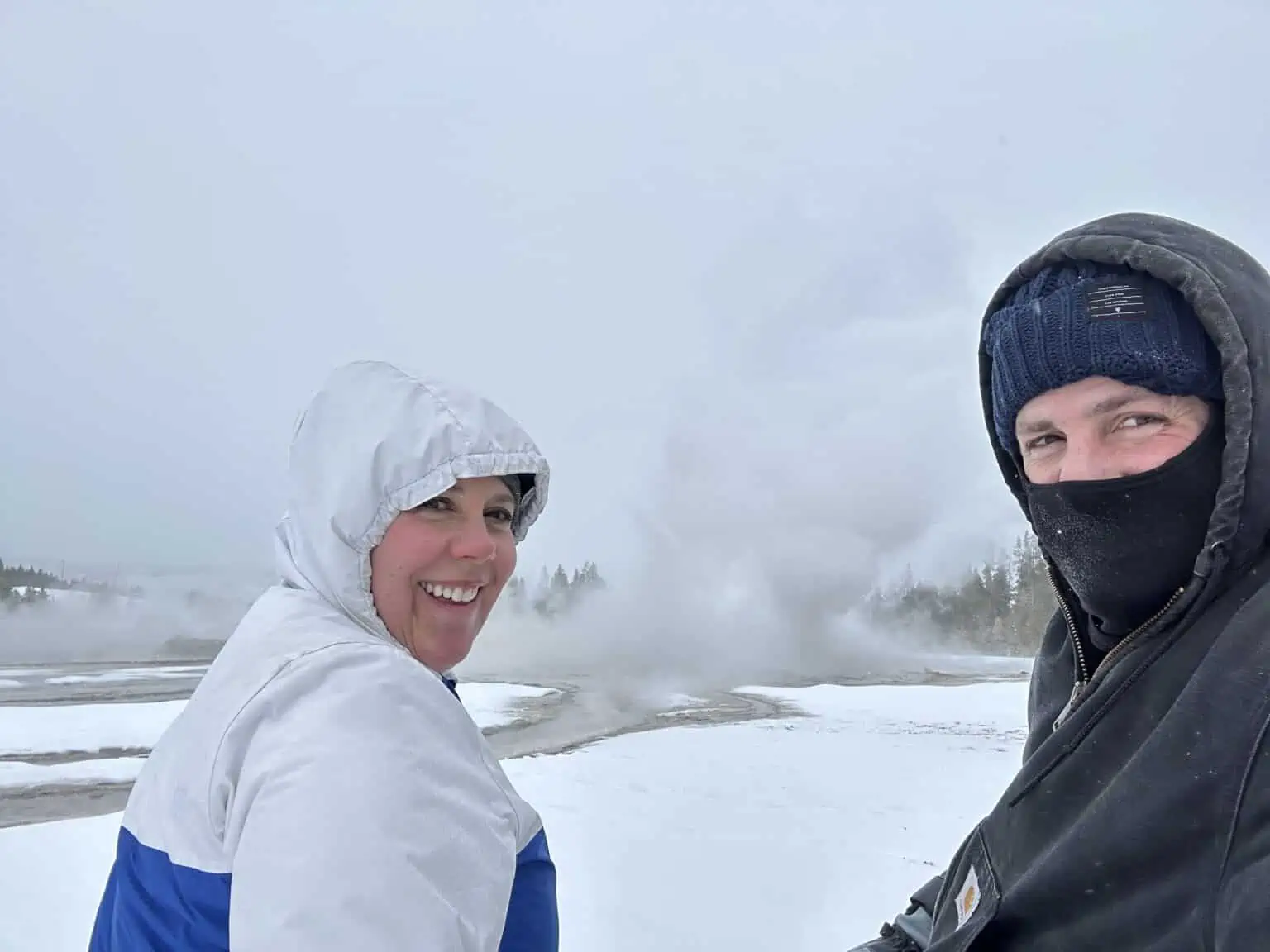
Many guests tour the park from the warmth of a snow coach. After waiting outside for an hour to watch Riverside Geyser erupt, I don’t think that’s a bad idea!
What Parts of Yellowstone Are Closed?
As mentioned earlier, the majority of the park is shut down. This includes campgrounds, hotels and lodges, restaurants, most visitor centers and ranger stations, camp stores, gas stations (you can still pay at the pump at some of them) auto service stations, and medical clinics. If you need any of these services, your best bet is to head to the gateway towns of West Yellowstone or Gardiner, MT.
The winter travel season lasts through mid-March, but services don’t completely open again until Memorial Day and even early June! This is because the NPS has to wait for the snow to melt and clear the roads.
We know several people who tried to visit Yellowstone in early May and had to cut their trip short because of a late snowstorm shutting down the park.
What Parts of Yellowstone Are Open?
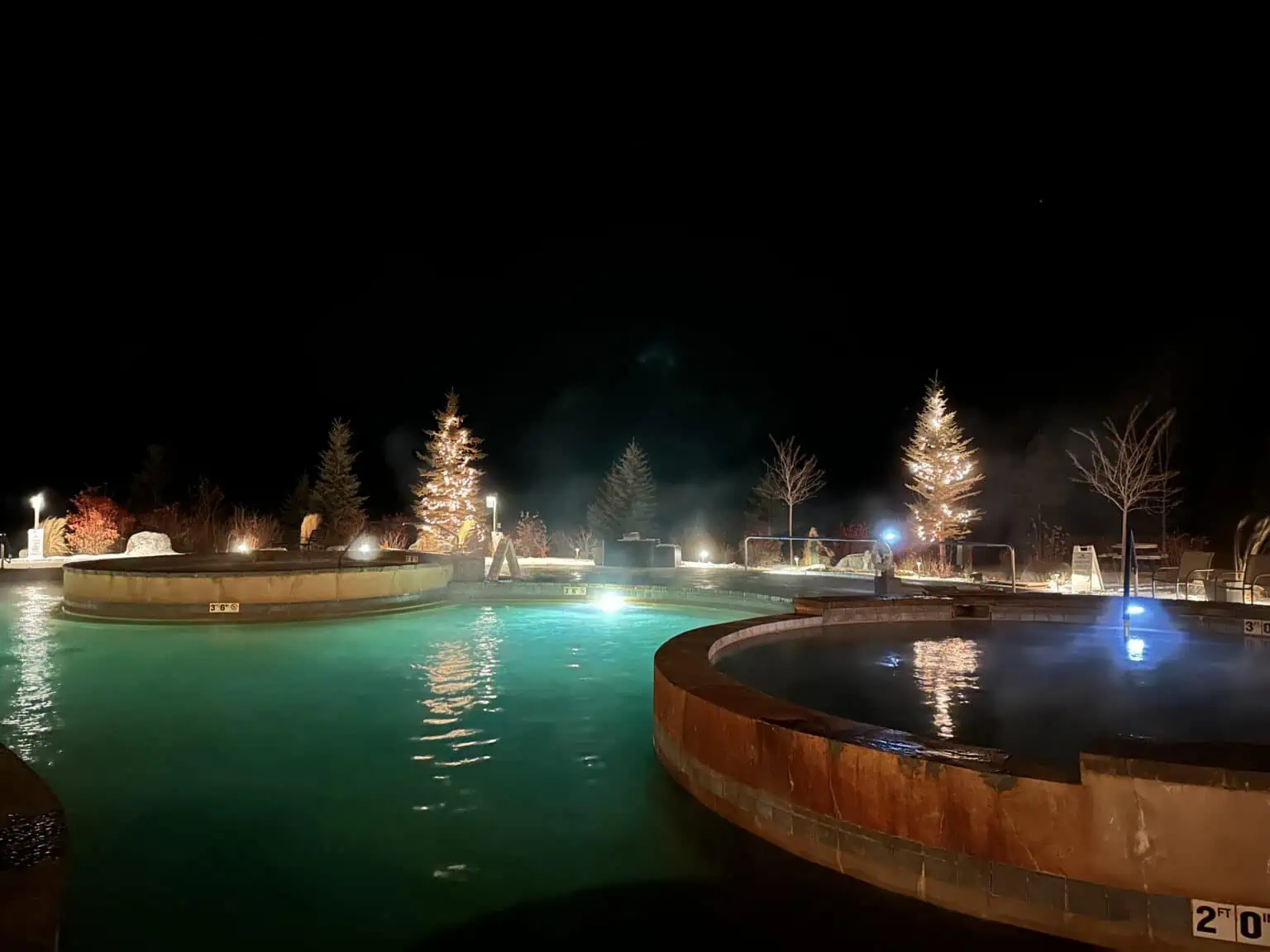
There are actually quite a few places that guests can visit, either in their car or on foot in the town of Mammoth. We enjoyed walking around the Albright Visitor Center and looking at the displays. The Yellowstone Archives are also open. This is a great stop right outside the north entrance of the park if you are into history!
We also soaked in Yellowstone Hot Springs one evening. It’s a beautiful facility that we really want to go back to when we visit in the summer. Even though the water in the springs ranges from 90-100 degrees Fahrenheit, I wore a beanie while in the pools and wore my snow boots with my swimming suit walking to the locker room!
Check out our Complete Guide to Mammoth Hot Springs in Yellowstone for more hot springs nearby.
We were able to walk to the Old Faithful Visitor Center from our cabin at the Old Faithful Snow Lodge.
Bear Den Ski Shops located at both the Mammoth and Old Faithful Snow Lodge are open and rent winter gear such as snowshoes and cross-country skis.
Not sure which Yellowstone Entrance is right for you? Download our Free Quick and Easy Guide to Yellowstone’s Entrances! Get the PDF Now!
Gardiner, MT, and the North Entrance
Gardiner, MT has the most tourist services available of all the gateway towns to Yellowstone. Plenty of locals live here and the roads being plowed allow guests to visit the park without the added expense of booking tours.
Gardiner is charming and we loved our stay at the Yellowstone Gateway Inn. We got a great rate with it being off-season and loved how close it was to everything. We also ate at the Wonderland Cafe, the best restaurant in Yellowstone and the surrounding areas (in our humble opinion!) Matt loves their elk chili.
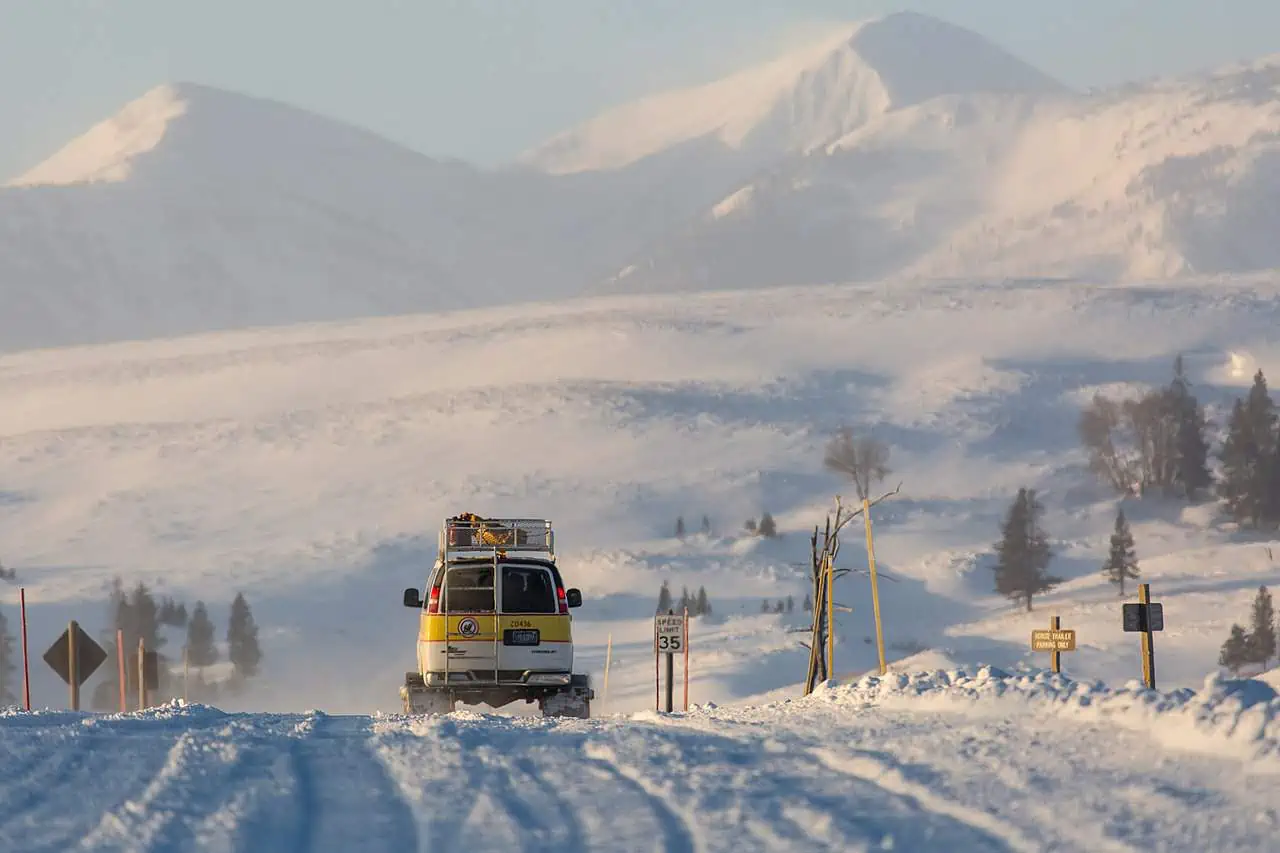

West Yellowstone, MT, and the West Entrance
If you want to see mountains of never-ending snow, look no further than West Yellowstone! Here you can see snow drifts over 6 ft high. Even this small mountain town leaves its roads unplowed to allow snowmobilers easy access to the park.
There are gas stations, hotels, restaurants, and even a few stores open, but you won’t be able to drive your private vehicle into the park. You’ll need a snowmobile or snow coach for that. Guests can also access Yellowstone from the south entrance (Jackson, WY) or the east entrance (Cody, WY) via snow coach or snowmobile.
What Is There To Do?
Our winter trip to Yellowstone was 4 days long (including travel days). We had plenty to do and left feeling like we could have done more. Here are some popular activities guests enjoy at Yellowstone in the winter.
Geysers and Hot Springs
Geysers don’t care if someone is watching or not. They continue to erupt but viewing them is different; Here’s how.
First, the boardwalks to view the geyser basins aren’t cleared. You are literally walking on top of 4 ft of packed snow. At first, I was concerned about this because I liked the guard rails that are normally there to keep me on the path. However, I quickly found that you can tell where the geothermal features are because the snow is melted around them.
Second, the geysers aren’t as pretty. The cold air makes more steam which makes it difficult to distinguish the erupting water from the steam. The springs also lack the bright blue colors they have in the summer. I’m not sure if it’s because the water temperature is cooler, thus allowing the more orange and yellow microorganisms to grow, or if it’s the lack of sunlight creating that pop of color.
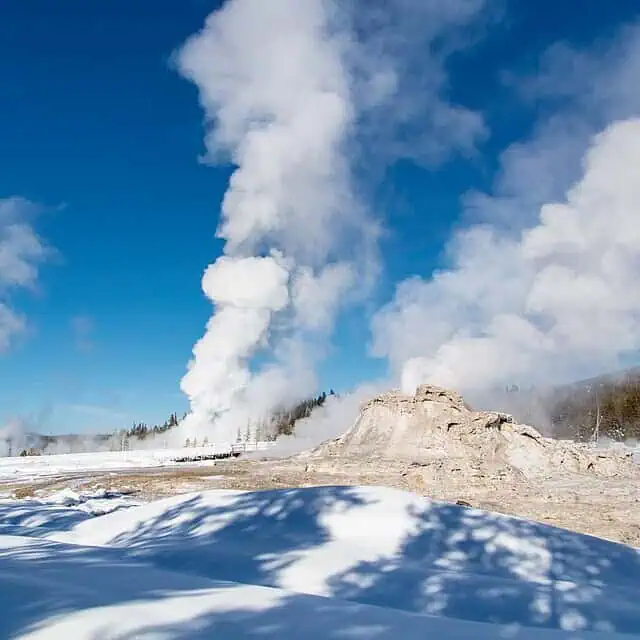
Third, you pretty much get the geysers to yourself. Normally, the Mammoth Terraces are PACKED! Not in winter. We walked around for about 40 minutes and never saw another person.
Tours
There is no shortage of tours available in the winter. They are a necessity if you want to see any part of Yellowstone besides the northern part of the Grand Loop Road. Although there are several private companies that transport guests in and out of Yellowstone and offer tours, Xanterra is the official concessionaire that runs winter tours for Yellowstone National Park.
Tours include options to visit the Grand Canyon of the Yellowstone, Old Faithful Geyser Basin, West Thumb, and wildlife viewing tours. You can check out what they have to offer at the Yellowstone National Park Lodges website.
Tours and shuttle services from private companies depart from West Yellowstone, Jackson, Cody, and Gardiner. Here is the comprehensive list of authorized tour companies.

Cross Country Skiing and Snowshoeing
One thing we have noticed is that Yellowstone is for sightseeing in the summer and recreation in the winter. We met several people who were visiting just because they loved to cross-country ski. There are several packed ski trails throughout the park.
We brought our own snowshoes and blazed a few trails but our favorite was when we went on a guided snowshoe tour from the Old Faithful Snow Lodge. Our guide led us to places that are usually off-limits during the regular travel season and pointed out animal tracks and habitats along the way. It was a delight.
Ice Skating
The Old Faithful Snow Lodge has a very small ice-skating rink out back. It’s a pretty cute little area with a fire pit and Christmas lights. Ice skates are available on the honor system for hotel guests to use.
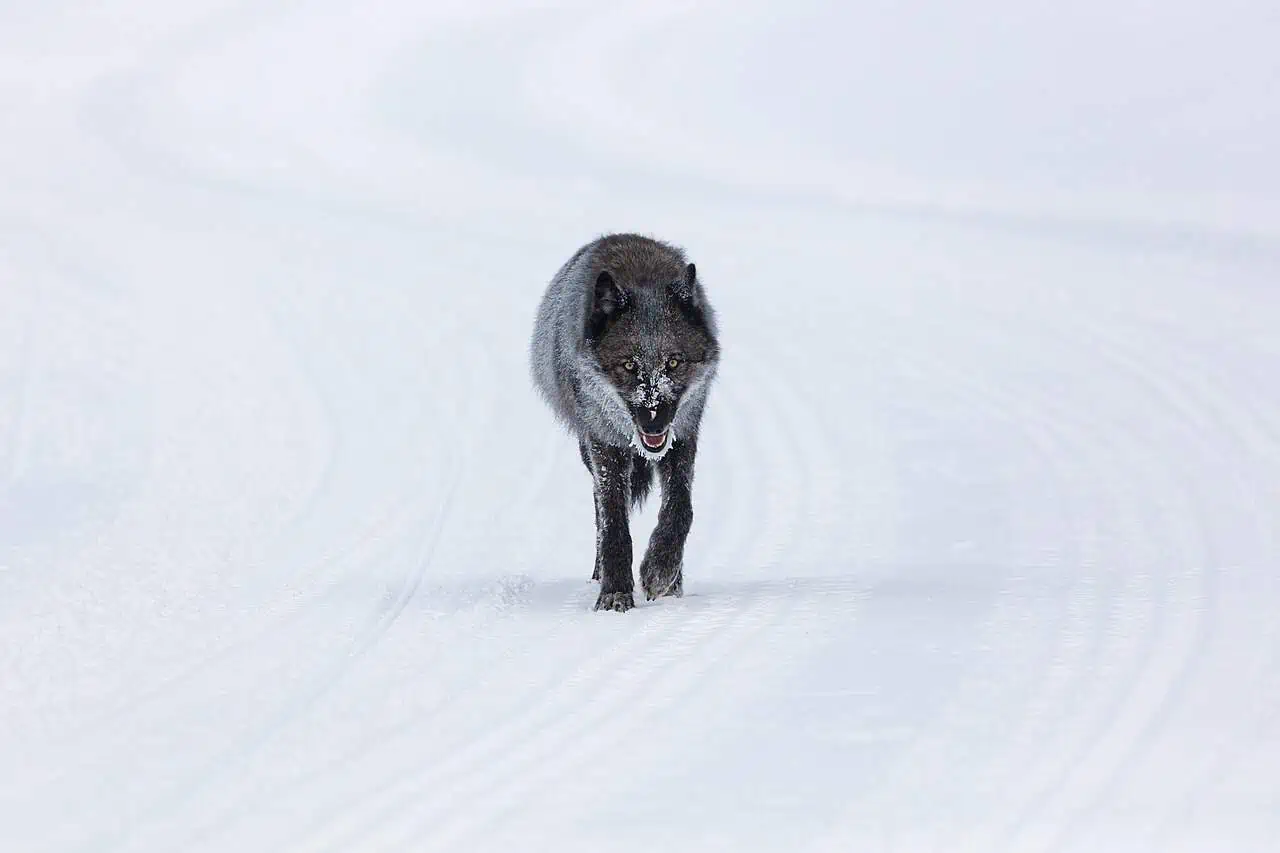
Many other animals, like bison, hang around closer to where people are than usual. Bison are migratory animals and one of the herds actually migrates out of the park and into the city of Gardiner and beyond.
The bison population of Yellowstone has exceeded what the park can support so state and tribal hunts are held during certain parts of the year. We drove a little way out of the park and witnessed one of these hunts. Although we understand this is probably the best solution at the moment, it is still hard to see.
Snowmobiling
This is a huge thing to do and you will see lots of snowmobilers inside and outside of the park. For those who wish to bring their own snowmobile, the park service requires a permit that is given out via lottery system. People wishing to do this can apply in the fall and limited amounts of permits are given. There are also several regulations.
If you aren’t able to get your own permit or would like to do a tour, there are plenty of companies authorized to do this. Check out this comprehensive list of authorized snowmobile tour companies.
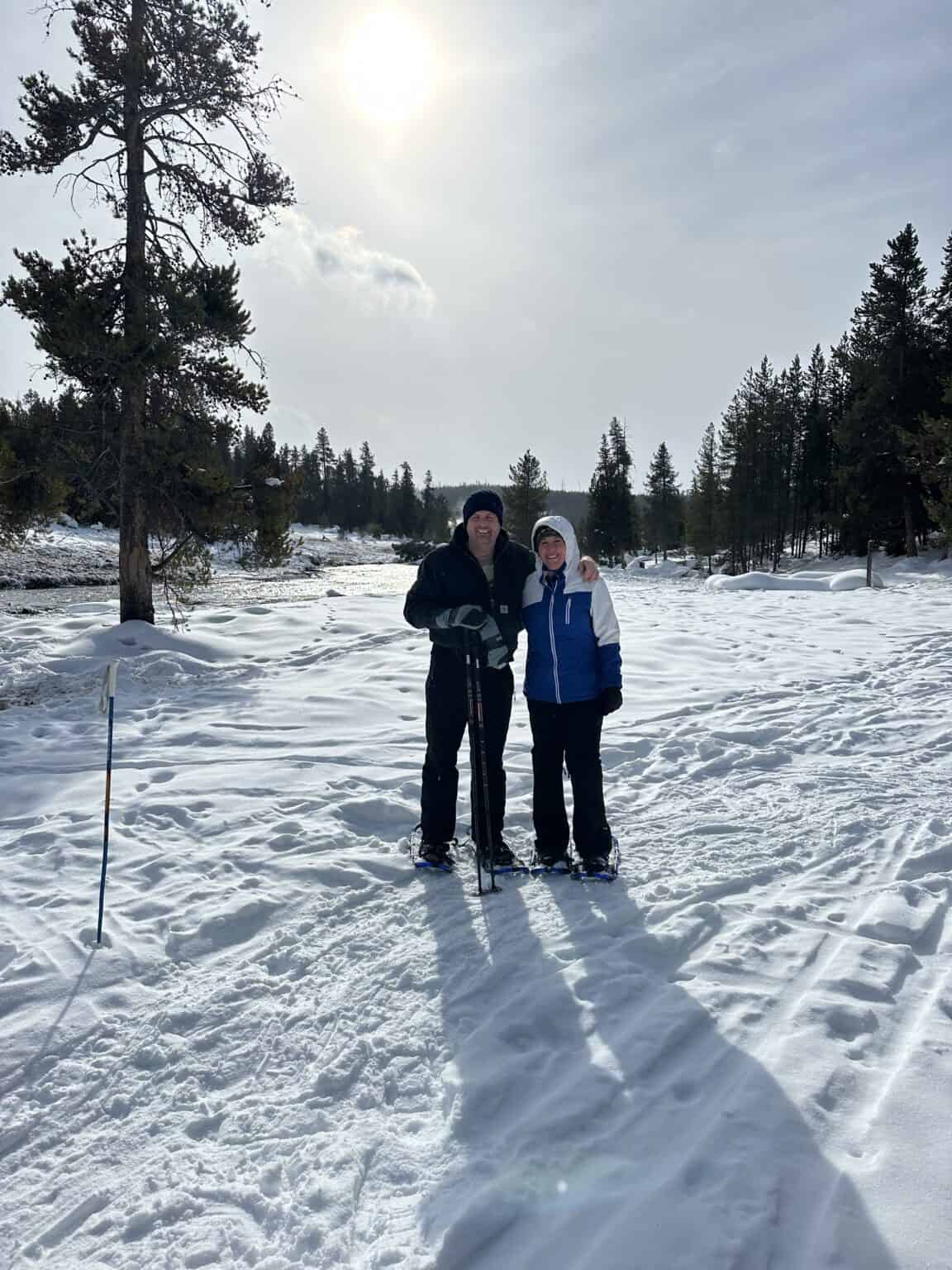
What Kind of Wildlife Can I See?
Winter is a fantastic time to see wildlife in Yellowstone. While visiting the north end of the park, we met several wolf watchers. Every morning they bundle up, grab their scopes, and camp out for the day to watch these amazing animals. We rented a scope and had no idea how to set it up. The kind wolf watchers helped us get the settings just right and we were able to watch a family of wolves just outside their den. It was so cool!

Do I Need a Car?
No. Although we used our vehicle for portions of this trip, both Xantarra and other tour companies have the option of picking guests up directly from the Bozeman airport.
How to Plan For Your Trip to Yellowstone in the Winter
This was a bit more complicated than planning a trip in the summer. One of the biggest obstacles we faced was arranging our snow coach transportation with our in-the-park lodging.
If you go with a private snow coach or snowmobile company (which is often cheaper than Xanterra), you’ll want to make sure there is lodging available within the park between your drop-off and pick-up dates. The best advice we can give is to book your transportation and lodging at the same time.
Also, winter dates are not exact. Mother Nature is the boss here. There is usually enough snow on the road for snow coaches and snowmobiles from mid-December to mid-March, but that is all dependent on snowfall. Book January and February to reduce the risk of cancellation due to road conditions.
Final Thoughts
We are glad we visited Yellowstone in the Winter and we’ll probably visit in the winter again someday. It was NOTHING like visiting in the summer; the park was barely recognizable. Yellowstone in the winter is wonderful for photographers, people who enjoy recreation, people who hate crowds, and wolf watchers. However, if I was only going to make it to Yellowstone once in my life, I would go in the summer because there is so much more to see and do including waterfalls, more geyser basins, getting out on the water, and great outside the park activities.
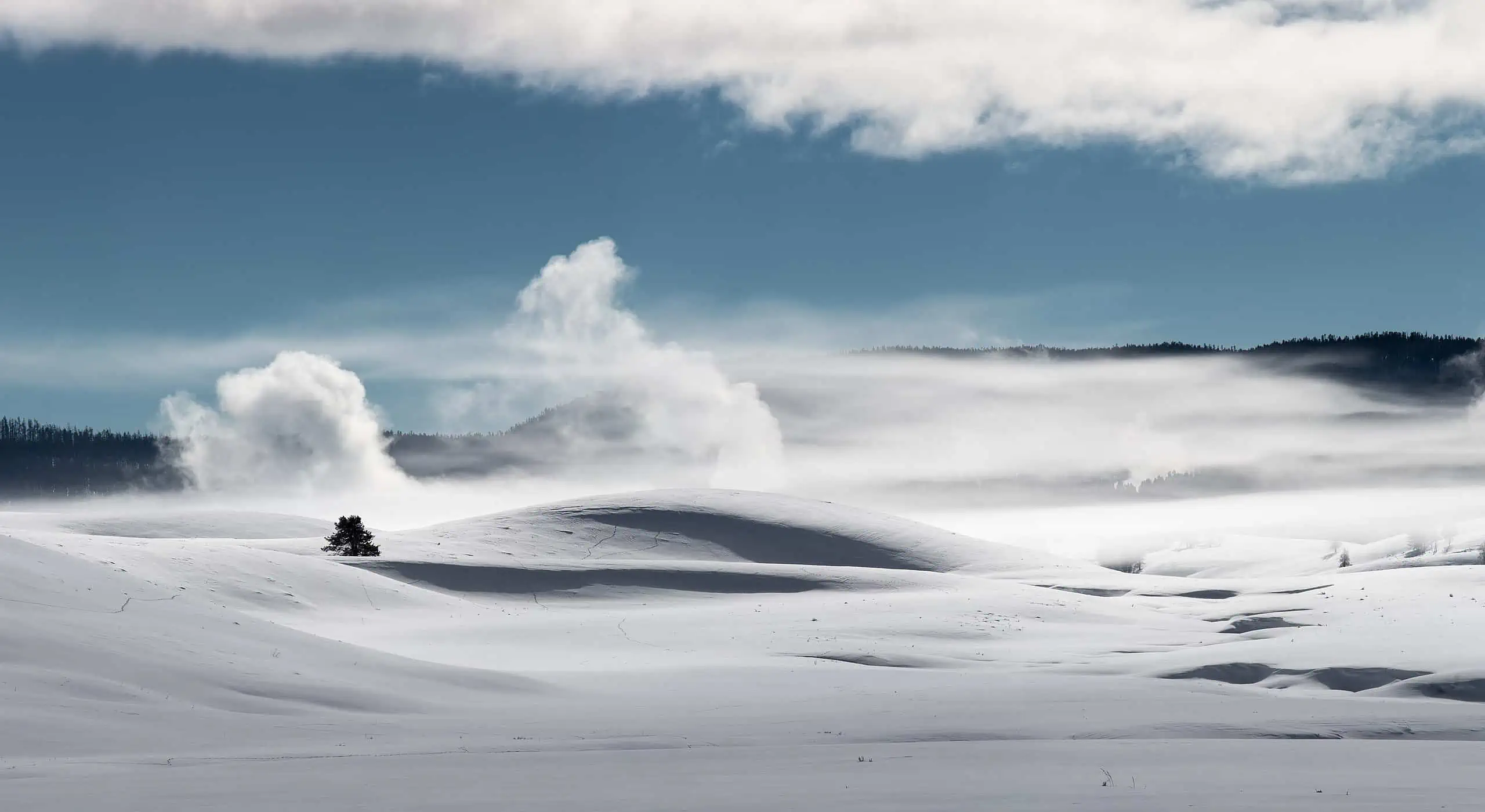
If you are planning to visit Yellowstone in the summer let us help you. Yellowstone is confusing because it’s huge and there are so many things to do!
Need a game plan so you don’t miss out on the best things to do in Yellowstone? Check out our itinerary.
Most travelers want to visit the most popular sites and still avoid the crowds. We have a detailed itinerary that gives you a step-by-step game plan so you can get to the best places at the right times.
Our itinerary includes a free audio guide to listen to while driving with over 3-hours of stories about the park.
Download Your Yellowstone Itinerary
YELLOWSTONE TRIP PLANNER: To read or watch all of our content about Yellowstone National Park, check out our Yellowstone Homepage
ENTRANCES: Yellowstone has 5 entrances: The West Entrance, the East Entrance, the Northeast Entrance, the North Entrance, and the South Entrance. Learn which entrance to Yellowstone is right for you with our Free Quick and Easy Guide
THINGS TO DO: Don’t miss all that Yellowstone has to offer including Old Faithful, the Grand Prismatic Spring, Yellowstone Lake, Norris Geyser Basin, Mammoth Hot Springs, and West Thumb and Grant’s Village
GREAT CITIES TO STAY OR CHECK OUT: Learn all about where to stay and where to camp when visiting Yellowstone and things to do in Cody, Wyoming, and other areas surrounding Yellowstone
WHERE TO EAT: Check out the best places to eat including the Old West Dinner Cookout and also where to get groceries and eat picnics in Yellowstone National Park
KNOW BEFORE YOU GO: Find out if you need a reservation or bear spray and binoculars, as well as tips for driving in and flying to Yellowstone
WATCH: Enjoy videos of gorgeous Yellowstone National Park while learning our best tips for visiting by watching us on The Parks Channel or our Yellowstone YouTube Playlist
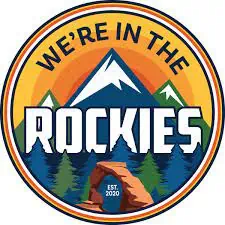
Matt & Cheryl Schoss have been road-tripping in the West and seeing the national parks for more than 20 years, first as students in their home state of Utah, and now with their four kids. They’re both teachers—Matt is an adjunct American history instructor at Weber State University, and Cheryl has taught special education for 25 years. Learn more about them and receive weekly newsletters on the Best of the West including: essential travel tips, park updates, stories, and their favorite things to see and do at https://wereintherockies.com/.
Top photo of skiers in Lower Geyser Basin by Neal Herbert/NPS.

